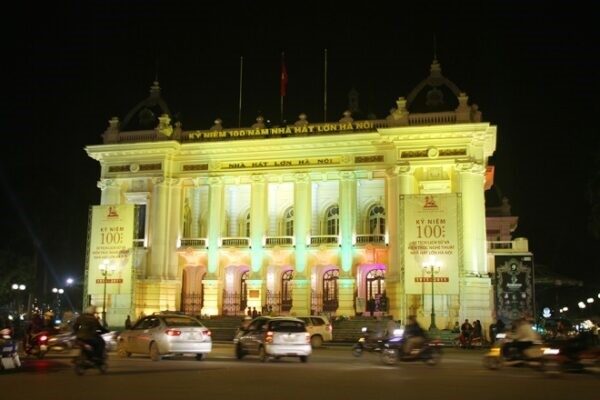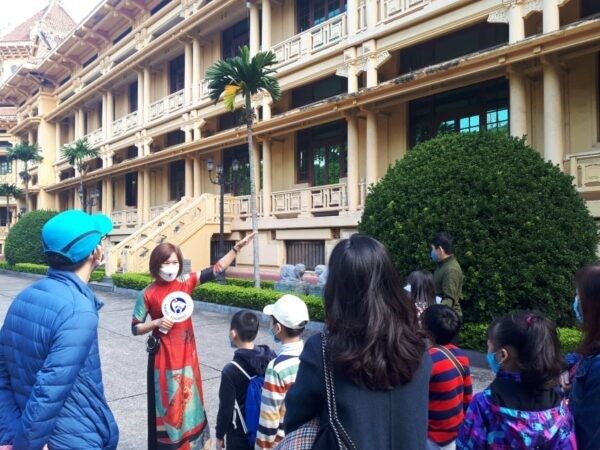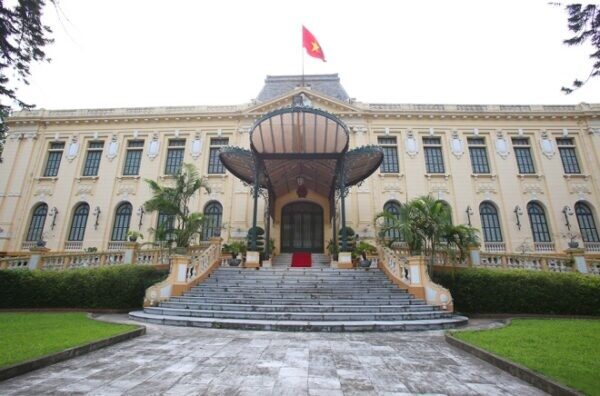
Hanoi Opera House is a work containing unique values of history, culture, architecture and fine arts. Completed in 1911, the Theater was then used as a place to perform classical art forms such as Opera, chamber music, and drama. On August 17, 1945, at the Theater Square, a rally in support of the Viet Minh front took place; this is also the place where the first session of the National Assembly was held, on March 2, 1946… Photo: BXD
For nearly a century in Vietnam, with the dream of a ‘French administrative capital in Indochina,’ the French built many architectural works, of which, prominently, were Western-style offices and cultural buildings. After more than 100 years of existence, up to now, these buildings are still in use, are typical architectural highlights of the Capital, contributing to creating an urban appearance that is both ancient and modern. In other words, these works have become valuable cultural, architectural and functional heritage in Hanoi. These heritages and works are inherently unique, but even more unique when they are associated with historical events of the capital and the country.
With that in mind, on October 23, the Vietnam National Museum of History cooperated with Hanoitourist Travel Company to organize the Opening Ceremony of the Walking Tour “French Architecture in the Heart of Hanoi”. This will be one of the unique, impressive and attractive journeys for visitors to choose when they want to learn about the capital Hanoi – the convergence of sacred air and the quintessence of the country’s mountains and rivers with safety criteria to serve the needs of tourists in the capital and the whole country in the new normal.

The Vietnam National Museum of History was built to inherit from the Louis Finot Museum, designed by architects namely C.Batteur and E.Hébrard. This used to be the Museum of École française d’Extrême-Orient, the work was started in 1926 and completed in 1932. Photo by HH
The walking tour starts from the National Museum of History – a masterpiece of East-West architecture and a red address as a place to store, display and introduce Vietnam’s history from prehistory to today through a system of documents and valuable artifacts, many of which are national treasures. Within 1 hour and 30 minutes of walking through the beautiful street corners of the central area of Hanoi, visitors will feel like they are lost in a space of architectural art and history through the typical famous works of Hanoi such as the Grand Opera House, the historical relic of the Northern Revolution, the Sofitel Metropole Hotel, etc.
The unique feature of this tour is the connection of 3 attractions, helping visitors to have an overview, identification and comparison to see the outstanding value of architectural works, architectural style, the interference and acculturation of Vietnamese culture with Western culture in the early 20th century, and at the same time connecting events and artifacts displayed in the Vietnam National Museum of History with the Opera House and the historical relic of the North. Not only from an architectural perspective, but also a historical event that creates a panorama to help visitors gain a deeper understanding as well as new experiences during the tour.

The Northern Palace is a two-story house at No. 12, Ngo Quyen Street, Hanoi. During the French colonial period, this building was the Palace of the Governor of Tonkin. From 1954, the Northern Palace was remodeled and became the Government Guest House. Photo: BXD
To ensure safety and according to regulations in the current period, each tour group will have no more than 10 members, the groups will keep their distance and not contact each other according to the motto “no touch”. After the opening ceremony, the walking tour “French architecture in the heart of Hanoi” will continue to be held every Saturday and Sunday.
H.A
